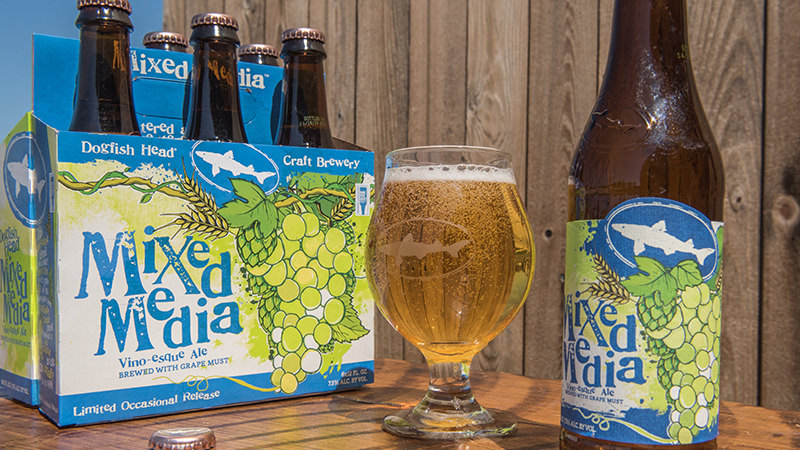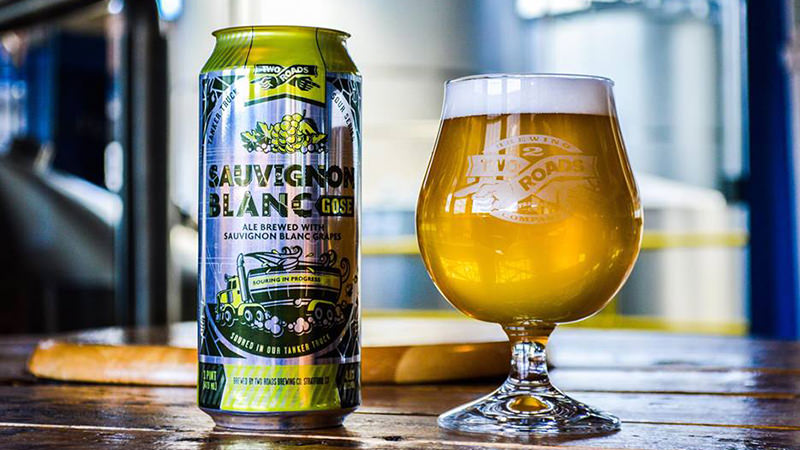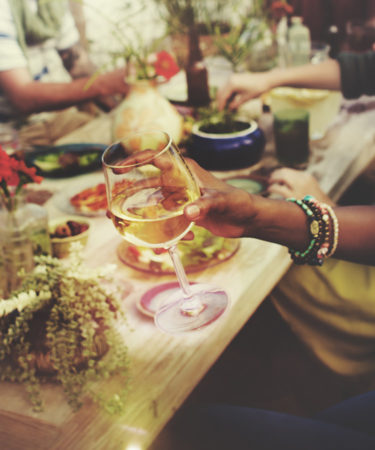Our palates are becoming more promiscuous. According to IRI Worldwide, a market research company, adults of all ages are reaching for different alcohol styles instead of sticking to just one.
“Millennial and Gen X consumers are the most experimental in the type of alcohol they choose and enjoy trying different kinds of alcoholic beverages,” IRI reports, noting that Gen X respondents averaged 3.6 different kinds of alcohol at home in the past three months, and 2.8 types on premise. Furthermore, the report found that contemporary drinkers of both generations “prefer bars and restaurants that put a creative spin on the alcoholic drinks they serve, and they are the most willing to try the latest trends.”
At the same time, brewers and vintners are breaking down barriers of their own, creating beverages that straddle the beer and wine worlds, marrying grape and grain in ancient-inspired yet future-fitting ways. As a result, a new cast of beer-wine hybrids is playing out on the American drinking stage. These brews go beyond wine barrel-aging beer and step into new fermenting territories. Some beer recipes incorporate ingredients like grape must and wine yeast to create a beverage that’s part beer, part wine, and, in the best cases, all delicious.
The practice predates our current craft boom by some 40 years. As far back as the 1970s, Belgium’s Cantillon annually released Cantillon Vigneronne, a lambic made with Italian muscat grapes and aged in oak barrels. In the early 2000s, Belgian brewers Bosteels and Malheur championed the bière de Champagne or bière brut style of beermaking, mimicking winemakers’ remuage and dégorgement processes.

But the beer-wine hybrid movement had already taken hold stateside by the 1990s, thanks to ever-curious Dogfish Head Craft Brewery. Its first grape foray, Raison D’Etre, brewed first at its brewpub in 1996 and then bottled for distribution in 1998, used partially dehydrated green raisins. Then, in 1999, came its Ancient Ales series, beginning with Midas Touch, a mead-leaning hybrid brewed with white Muscat grapes, barley, wildflower honey, and saffron. It was inspired by ingredients found in 2,700-year-old drinking vessels found in the tomb of King Midas. Later, in 2011, Noble Rot billed itself a beer-wine hybrid brewed with “benevolent fungus,” botrytis-infected Viognier must and Pinot Gris must; and Sixty-One, released in 2013, was a riff on the continually hopped 60-Minute IPA, adding the addition of Syrah grape must.
Most recently, Dogfish Head debuted Mixed Media, a beer similar to a saison that also incorporates late-harvest Viognier grape must, offering notes of white grape and melon, and a spicy, white wine-like body, thanks to a Belgian yeast strain.
“By blending the two seemingly opposite worlds of beer and wine together we’ve discovered that they collide quite nicely, and the combination of the two adds an additional thread of flavor and a layer of complexity to the mix,” Sam Calagione, Dogfish Head founder and CEO, said in a press release. “Our newest spin, Mixed Media, is perfect for wine drinkers who are at beer drinking occasions or folks that enjoy a crisp, light Pinot Gris.”
As Calagione alludes, beer-wine hybrids are a way to entice both types of drinkers to the table. But it’s not just a fun party trick — brewers are seeing their seduction techniques deliver at the retail level. “The beer reaches across the aisle,” Blaine Landberg, whose California brewery, Calicraft, makes a sparkling ale called Buzzerkeley, told Imbibe in 2014.
The same happened for Odell Brewing, of Fort Collins, Colo. when it released Amsute, an imperial porter aged in oak wine barrels accented with Colorado-grown Tempranillo grape juice; and Jaunt, an oak-aged pale ale made with Colorado-grown Riesling grapes: “They made it into wine stores around town where they didn’t normally sell beer,” Eli Kolodny, Odell’s quality manager, told Imbibe.
And when Allagash Brewing of Portland, Maine released its sibling beer-wine hybrids, Victor and Victoria, brewmaster Jason Perkins said, “Many wine drinkers are set on only being wine drinkers. Beers like Victor and Victoria are another way to draw them in.”
It’s happening the other way around, too. Winemakers are adding hops to their wines, like the Infinite Monkey Theorem Dry-Hopped Sauvignon Blanc natural wine available in adorable and portable 250-milliliter cans; and Field Recordings’ 2017 Dry Hopped Pét Nat. “We’re trying to bring some of that craft beer energy into boutique wine,” Field Recordings’ winemaker, Andrew Jones, told Food and Wine in March.
Whatever your preference — a dry, mineral-driven Sauvignon Blanc in the form of a tart and salty gose, or a sour amble ale that tastes like a punchy Pinot Noir — there are brewers aplenty putting unique spins on the beer-wine hybrid trend.

10 Beer-Wine Hybrids to Try
Hudson Valley Purelake
This sour IPA conditioned on Gewürztraminer grapes and hopped with Mandarina Barvaria and Hallertau Blanc hops is grapefruit juice-bitter with notes of pineapple and white grape.
Two Roads Sauvignon Blanc Gose
Part of Two Roads’ ever-evolving Tanker Truck Series of fruited sours, Sauvignon Blanc Gose marries the mineral salinity and tropical punch of Sauvignon Blanc grapes with the tart, refreshing saltiness of Two Roads gose.
Dogfish Head Mixed Media
This “saison-esque” ale takes 51 percent of its fermentable sugars from grain and 49 percent from Viognier grape must. The result is as legally “wine” as a beer can get.
Allagash Victor
This hybrid starts with a mash of Pilsner malt and Maine-grown red grapes, then adds Hallertau hops and a two-part fermentation, first with wine yeast, then with a Belgian abby-style yeast strain. Its twin sister, Victoria, trades red grapes for 500 pounds of Chardonnay grapes.
Captain Lawrence Brewing Co. Cuvée de Castelton
This Great American Beer Festival gold medal winner is golden itself — a golden ale aged with brettanomyces yeast and Muscat grapes in wine barrels.
Cascade Brewing Barrel House Vitis Noble 2016
Available in-house or at local retailers near Cascade’s Portland, Ore. home, Vitis Noble blends sour wheat and blonde ales aged in oak for up to 16 months with Chardonnay grapes grown in the Willamette Valley.
Stillwater Oude Bae
A sour amber ale aged in French oak with Pinot Noir grapes.
The Bruery Yount
This varietal starts with the Bruery’s Black Tuesday imperial stout as a base, then blends and ferments with the skins and must of Cabernet Sauvignon grapes sourced from the Yountville appellation of Napa Valley. The viscous, vinous liquid is then aged in 100 percent new French oak puncheons for nearly a year.
Cantillon Vigneronne
This lambic beer made with Italian muscat grapes and aged in oak barrels made its debut in 1973 and still holds up beautifully today. To produce this wine-like lambic each year, the grapes are added to casks of two-year-old lambic during the grape harvest in October, then blended three months later.
LoverBeer BeerBera
Brewed once a year at Italy’s LoverBeer brewery, BeerBera is made with barley malt, Barbera wine grapes, sugar, hops, and wild yeast from the grape skins. It’s then spontaneously fermented in oak and matured for three months.
